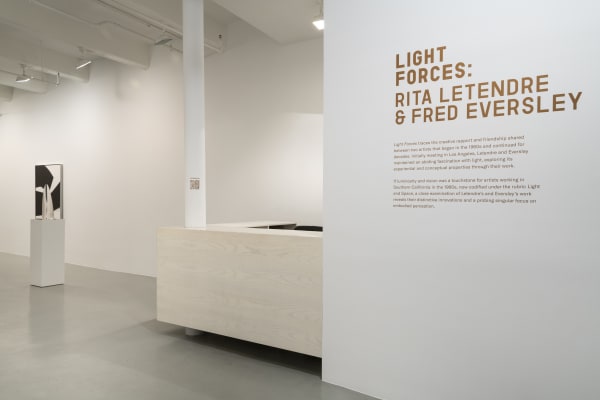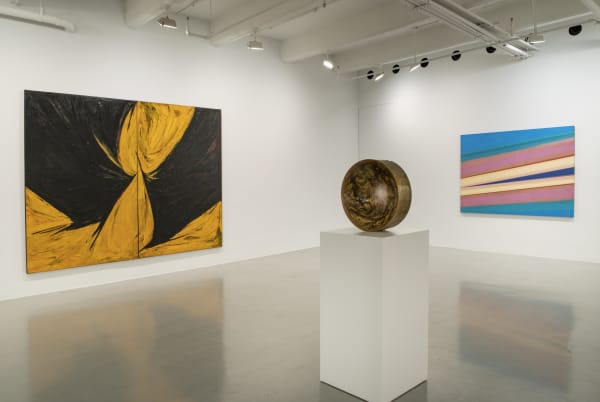Light Forces: Rita Letendre & Fred Eversley
Light Forces traces the creative rapport and friendship shared between Rita Letendre and Fred Eversley that began in the 1960s and continued for decades. Initially meeting in Los Angeles, Letendre and Eversley maintained an abiding fascination with light, exploring its experiential and conceptual properties through their work. If luminosity and vision were touchstones for artists working in Southern California in the 1960s, now codified under the rubric Light and Space, a close examination of Letendre’s and Eversley’s work reveals their distinctive innovations and a probing, singular focus on embodied perception.
Letendre arrived in Los Angeles in 1965, already an accomplished abstract painter. Recognized as a precocious talent in the dynamic Montreal art scene of the 1950s, Letendre became an adept automatiste—Quebec’s response to abstract expressionism that was inflected with political undertones. Her work of the early 1960s manifests a fixation with the theme of light; paintings like Solstice (1962) blaze with an intensity that calibrates seasonal extremes with internal flames.
At California State University, Long Beach, Letendre executed a large outdoor mural that translated her textured paint application to a flat, monumental dimension. Arresting in its forthright presentation of painterly forms coalescing, Sunforce (1965) dominates the architecture, bridging two campus buildings and fronting a long passageway. Rectilinear and curvaceous black forms abrade, causing color to cascade—the mural serving as a collider. Sunforce was a declaration of ambition. It established how, in California, Letendre would develop formal solutions at a rapid rate, utilizing prior knowledge to pioneer new pictorial solutions.
Amidst this fertile cultural moment, Fred Eversley first encountered Rita Letendre. Eversley—a highly trained electrical engineer who moved to Los Angeles in 1963 to work for Wyle Labs to build acoustic laboratories for NASA’s Apollo and Gemini missions—partially credits Letendre for his decision to become an artist. Following a car accident in 1967 and a long convalescence, Eversley’s rapport with Letendre and her sculptor husband Kosso Eloul and their circle of friends led to his existential shift—directing scientific acumen toward aesthetic ends.
Once Eversley changed paths, he brought his science and technology background into his artistic practice. He quickly invented his first polyester resin spinning technique, utilizing centrifugal forces in molds attached to lathes and turntables. Through this method, he established his first body of work: transparent, multicolored cylindrical sections. These sophisticated early works led to Eversley’s first solo show at the Whitney Museum in 1970, including the cathedral form Untitled (1969).
There is a metaphysical dimension to Eversley’s work. The sculptures operate like portals, visual conductors that tint and shape vision, directing it through space. Spanning a range of subtle and vibrant hues, Eversley’s chromatic reach encompasses the visible spectrum, conjuring different densities of the same color within specific works.
Letendre’s work, as it developed throughout the 1960s, moved toward an ever more precise assertion of color. With hard-edged intensity, vectors of color cleave total darkness in an angular, vertiginous space. Her painting developed a more complex geometry following her final move to Toronto in 1970, when Letendre began using the airbrush to achieve atmospheric, at times celestial, effects.
By the early 1970s, each artist had attained a signature formal vocabulary. Eversley’s was the iconic parabolic lens, which he perfected over decades and continues to explore. The parabola is the only shape that focuses all forms of energy, including light, to a single focal point. It captures within itself an image of the surrounding environment, seeming both to project imagery while also being possessed of an internal energy source.
From his studio in Venice, California, Eversley pushed the boundaries of experimentation—exploring color combinations and the opacity of pigments, at times revealing traces of particles in liquid resin. Examples such as the swirling metallic black and gold lens from 2018 offer a scale-less, swirling cosmic image that materializes light within the orb.
When Eversley relocated in 2019 to his native New York, he was challenged to work with new dyes with different properties than his original media from the 1960s due to disruptions caused by the pandemic. Experimenting with these color saturations and spectral intensities, he achieved new chromatic effects. His most recent work in this exhibition, dating from 2021, is defined by a brilliant and nuanced density.
In 2022, Eversley returned to his foundational study of optical effects in his early cylindrical cut sections. He researched new materials and techniques in an effort to augment scale, seeking a grander bodily framework to allow viewers to interact with sunlight outside. The first monumental example of this larger-scale work is on view in his current career-spanning exhibition at the Orange County Museum of Art, where a transparent, vertical polyurethane sculpture assumes a corporeal dimension.
Letendre also elaborated her spectral vision through her paintings of the 1970s and 80s, creating public commissions on a grand scale that animated the urban environment, often on the exteriors of skyscrapers. In later years, her painting returned to re-engage the gestural, more tactile approach of her early work, infusing her directional, abstracted landscape motif with a gusty, elemental energy. Letendre remained highly productive throughout the past decades, until her passing in 2021.
Over the years, since their first meeting in Los Angeles in the mid-1960s, Letendre and Eversley remained in contact while living a continent apart, visiting when their paths crossed. By juxtaposing the works of these two distinct artists, one is afforded an opportunity to contrast their approaches to color and luminosity. Utilizing distinct media, Letendre and Eversley plumbed the depths of a life-spanning passion—the essence of light.
Through adjacency, it is possible to experience the unique formal achievements of these artists, each of whose contributions have been absent from conventional, mainstream art histories. This dual presentation of their work seeks to open a space for further interpretive possibilities, allowing the fertile early years of their development to be experienced and traced forward.
- David Moos
Light Forces was organized in collaboration with David Moos


























